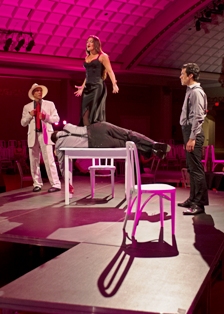
Cincinnati Does the Tango
(first published at www.ConcertoNet.com)

Tango is a deep subject. Not just a dance, it’s an outlook on life and a cultural timeline.
One need not know that to enjoy Astor Piazzolla’s tango operita “María de Buenos Aires,” which received its regional premiere in a co-production by Cincinnati Opera, the chamber group concert:nova and the Cincinnati Symphony Orchestra July 27 in the Music Hall Ballroom in Cincinnati. It aids comprehension, however, and broadens its artistic impact.
Piazzolla and Uruguayan poet Horacio Ferrer’s “little opera” (just over an hour without intermission) is a surreal vision of despair followed by hope, just as the tango, born in loneliness and deprivation in the slums of Buenos Aires, emerged to become an emblem of national pride and evolved, largely through Piazzolla’s music, into nuevo tango, a tango/jazz hybrid incorporating elements of European classical music.
Colombian soprano Catalina Cuervo starred as María, a prostitute obsessed with tango who lives on the edge, is murdered and returns as a Shadow (spirit). Mexican-American baritone Luis Alejandro Orozco sang the Payador (a gaucho minstrel) and smaller male roles. Colombian actor Jairo Cuesta, in white suit and fedora, performed the speaking role of the Duende (goblin), who narrates the story. Noted tango artists Fernanda Ghi and Guillermo Merlo scorched the Ballroom floor with their flowing, sensual dancing.
Conductor Edwin Outwater, music director of the Kitchener-Waterloo Symphony (Ontario, Canada), led concert:nova, which, as in Piazzolla’s 1968 original, comprised 11 musicians: a string quartet, double bass, flute, piano, guitar and two percussionists, with noted bandeonist Ben Bogart and world/ethnic music specialist Daniel Stein on violin. Six singers acted as a kind of Greek chorus, commenting on the action. The soloists, who sang in cabaret rather than operatic voices, wore body mikes.
Understanding the text of “María” is problematic even for Spanish speakers, since it is written in Lunfardo, a slang dialect originating in the prisons of Buenos Aires during the 19th century. One wished for surtitles or a detailed synopsis. Instead, the program contained a nutshell description of each of the 16 scenes. For additional help, the chorus and Duende occasionally spit out a bit of English translation.
To say the production was staged is a bit of an exaggeration. Directed by Argentine native Jose Maria Condemi, it was nevertheless ingenious. The Ballroom itself was the stage, with the audience seated at tables and chairs cabaret-style, surrounding three wooden platforms and framed at one end by the instrumentalists. The Ballroom bar to one side made a perfect setting for supernumeraries to gather, gape, smoke and drink.
The characters made entrances and exits through the audience, and the platforms served as loci for the action, including María’s stabbing and funeral, her return as the Shadow in a black trench coat and a very explicit rape scene in which the Shadow conceives a “new” Maria. (Ferrer’s poetry has quasi-religious connotations in its appropriation of sacrificial death and rebirth and the bandoneon, interestingly enough, began as a kind of portative organ used for religious services in Argentina.) Opera designer Thomas Hase’s lighting bathed the raised areas in white and suffused the room with reds, pinks, blues and greens.
Cuervo was ideal as María: sultry and dangerous in her “Je soy María” (“I am María”) -- not exactly a credo, but a statement of who and how fatal she is -- then softly redemptive as the Shadow with her infant (herself?) swaddled in black. Similarly, Orozco conveyed his poetic texts with both menace and beauty, cradling the baby tenderly at the end. Cuesta as the gruff-voiced Duende, who loves María (but also stabs her), brought overall unity to the piece.
With its mix of indigenous folk, jazz and European classical music, “María” invites comparison to George Gershwin’s “Porgy and Bess.” There were energetic instrumental tangos, tango songs, even a fugue as María arrives in Buenos Aires. Outwater led the concert:nova musicians with great skill, communicating precisely with the singers and dancers throughout the ballroom. The ensemble and guests Bogart and Stein performed with brilliance and sensitivity, crafting many spellbinding moments.
The production was a landmark, both for concert:nova, whose imaginative, innovative programs have greatly enriched the music scene in Cincinnati, and for Cincinnati Opera as it moves into a new, expanded phase of operatic presentation. (See “Cincinnati Opera’s CO2, a New Era,” in News/Features on this site.)